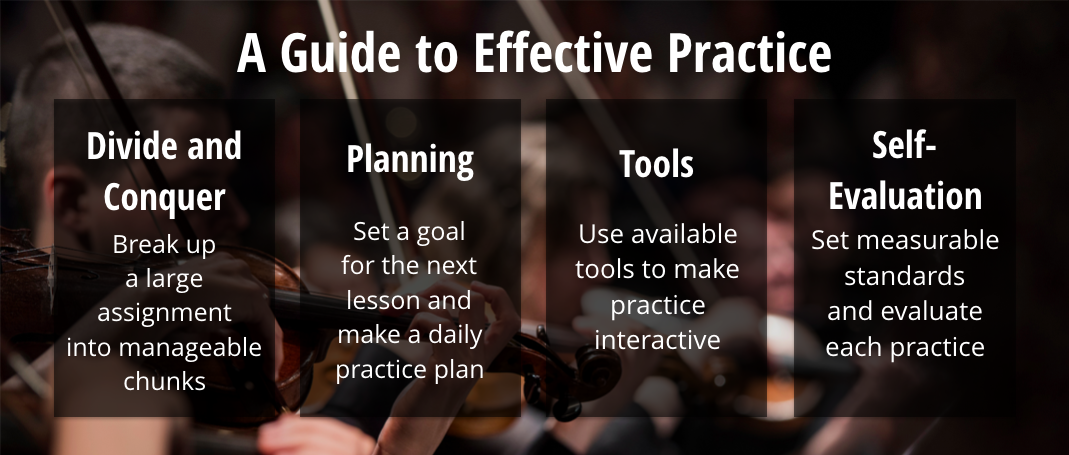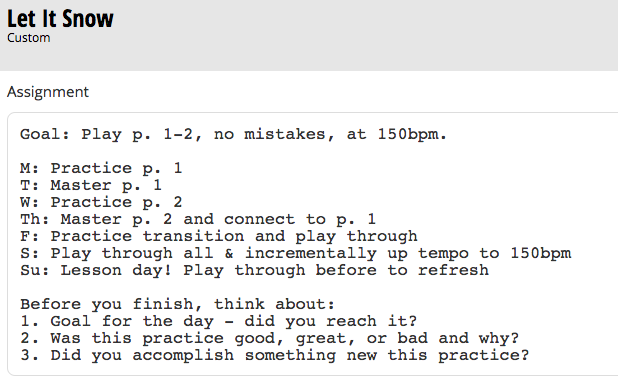Dump the Notebook: Writing Great Assignment Notes
Tell me if this looks familiar:
Teacher assigns a piece.
Sends student home to practice.
Student plays song over and over with one vague goal in mind: to improve.
Student goes to lesson.
Hasn’t improved much.
Is reassigned the piece.
Now, there are typically 6 days between lessons. 6 VALUABLE days that will (and should), when used effectively, bring the student to a higher level of playing by the next lesson. But practice is a solitary activity. A student who’s new to music (especially if others family members are not musicians) doesn’t have anything to model good practice behaviors over. They sort of go home and try their best to improve - but without any method. They’re just swinging in the dark. This can make improving hard, especially for those who are still trying their best to correctly read notes, rhythm, etc.
Students know what to practice but not how.
Practice structure should be changing as you improve - especially students who are finally moving from method books to pieces! Their practice structure should start looking different, but this is often overlooked (or the student is expected to look at this multi-page piece and somehow figure out something that works for them). To help a student make the most of every practice session, you might consider providing them with more detailed assignment notes - including a practice plan for each assignment.
I’m not saying you have to spoon-feed your students. I’m saying that by providing an outline, or structure, for their time away from lessons, they can be much more productive and learn effective practice habits to use and eventually coordinate on their own in the future.
Assignment notes should be a guide
Assignment notes should be descriptive enough to be a practice guide. Pure repetition doesn’t produce the best results. We even have data that shows that longer notes = longer practice!

What I see often (and what all of my teachers did) was to just flip to a piece and put a date or a “✔️” on it to indicate that this was your assignment for the week. Maybe they’d put a metronome marking and a couple notes on which pages to work on.
Practicing effectively was something I learned through years of trial and error - through my own experiences. My teachers would tell me what to practice, but not exactly how. And I know my teachers knew exactly what I had to do, but how could they write out detailed instructions when lesson time was already very limited?
Wouldn’t it be great if giving assignments with comprehensive, helpful notes was instant?
 Well, with Better Practice, it is! You can lesson plan out as far as you want, so when it’s time for the student to move on, all you have to do is TAP the next assignment on the screen to assign. Your assignment notes can also be saved - so if all of your students go through a certain curriculum, you only have to write the notes once. Essentially, you could create practice plans and self-evaluation questions for each piece and it would already be there for the next student. When it’s this easy, it doesn’t make sense to not do this!
Well, with Better Practice, it is! You can lesson plan out as far as you want, so when it’s time for the student to move on, all you have to do is TAP the next assignment on the screen to assign. Your assignment notes can also be saved - so if all of your students go through a certain curriculum, you only have to write the notes once. Essentially, you could create practice plans and self-evaluation questions for each piece and it would already be there for the next student. When it’s this easy, it doesn’t make sense to not do this!
So, what should be in the assignment notes?
Good assignment notes should help teach students good practice habits - so, it should guide a student through these elements of effective practice.

Planning (planning practice over 7 days)
I truly believe the problem of both lack of practice and ineffective practice starts with having no game plan. Students are held responsible for “practicing” a piece - but that’s very vague. They don’t know how to divide the work up each day, which also leads to the common thinking of, “I can skip a day and practice more the next day” - which often snowballs to walking into lesson having practiced no days. The assignment notes can be an area where you and/or the student write up a daily practice plan. This can be a simple 7-day outline on what to work on each day to reach a target for the next lesson. To develop a plan, students must first have a solid target for the next lesson. It should be something specific and measurable like “Play through page 2 flawlessly at 150bpm.” The more specific it is, the easier it is for the student to assess whether he/she reached it or not. Put it at the top of the assignment notes so the student always has it in mind. From there, think about the steps needed to achieve that goal and spread it out over the 6 days: divide and conquer! Often when the student moves to larger pieces, the thought of learning and practicing the whole thing by the next lesson is overwhelming. Dividing up an assignment can help the student make smaller milestones for each practice session. Below is an example plan using the same target:

This plan took me a grand total of 45 seconds to come up with. It’s really not a lot of work but holds you accountable for daily practice and gives you a solid target for every day as well as an overall goal for the next lesson! This also takes the focus away from how much time students are practicing as they are more focused on meeting the daily targets.
Tools
Even providing something like a metronome marking makes a practice session more interactive. Using a metronome, backing tracks, and videos are only a few of the ways you can incorporate tools into practice time.
Again, these might be a bit time-consuming for you to send to every student who plays a certain song. With Better Practice, you can attach all of these elements to an assignment and save it so it’s always there. Now, when you tap “Assign”, you’re not only handing over a comprehensive set of assignment notes with a practice plan - you’re also providing them with all of the resources they would need to practice.
Another really effective practice tool is recordings. Think about it - no one would want to submit a crappy recording. When I have to do recordings, I end up practicing extra just so that I get a good take - even if it’s not submitted to the teacher.
Thinking/Self-analysis (know when to be done with practice for the day (and when you’re not!))
This article goes over the bulk of what should be said here. Self-evaluation is critical to being productive. A lot of students just do their assignments and then call it a day, assuming that they’ve improved because they practiced. However, professionals think differently. They first have their goals, then they have standards for what was a good, great, or bad practice. Did they reach their daily goals? Are they on track for the long-term goal? Did they accomplish something new in this practice?
Writing self-evaluative questions like this in the assignment notes can urge students to become more active practicers instead of passive. They will get a good sense of how to be productive as they realize what characterizes their unproductive practices. But this all starts with an awareness of these issues - which you can guide them through with notes.

This is part of a new series called, Dump the Notebook, where we explain why using paper and pencil to operate is actually holding you and your students back. The notebook served a great purpose before but now with better tools available, you could do so much more that will help your students improve and simplify your life.
Providing good assignment notes is extremely helpful for a student practicing at home - especially since you can't be there to guide them every day. Writing things out in detail is not feasible with a notebook - so make the switch to Better Practice for quick lesson planning and saved assignment notes today!
 Better Practice Blog
Better Practice Blog